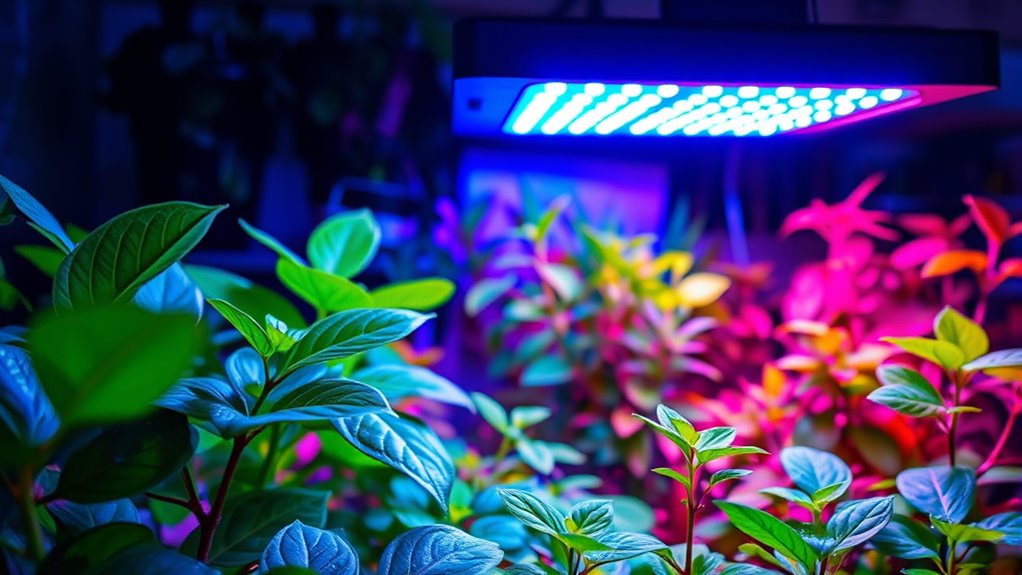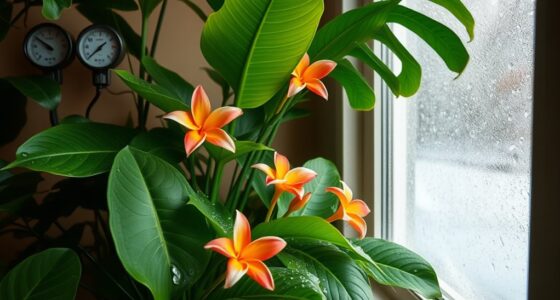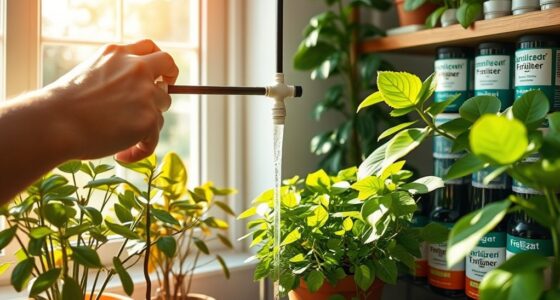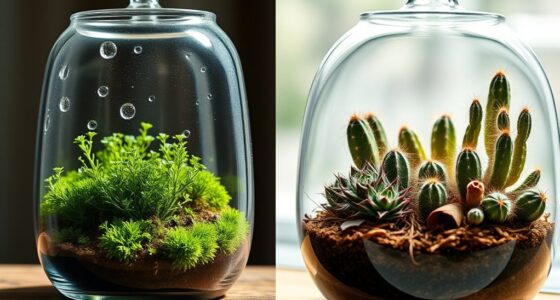To match grow light spectrum to your plant type, first identify whether your plants need mostly blue light for leafy greens and foliage or red light for flowering and fruiting. Use full-spectrum LEDs for versatile growth or select targeted lights with higher blue for seedlings and more red for bloom stages. Adjust light placement and color based on plant response, changing as they grow. To discover additional tips for optimizing your indoor garden, keep exploring this topic further.
Key Takeaways
- Identify your plant’s growth stage (vegetative or flowering) to select the appropriate spectrum, such as blue for growth and red for flowering.
- Use full-spectrum LED grow lights for versatile coverage, or adjust targeted spectrum lights to match specific plant needs.
- Match light intensity and duration to your plant type, providing more red light during flowering and blue during vegetative growth.
- Position grow lights at the optimal height (12-24 inches) and adjust as plants develop to avoid stress or stretch.
- Consider spectrum-adjustable grow lights to customize lighting conditions for different plant species and growth phases.

Growing plants indoors can be challenging without the right lighting, but grow lights make it easier to achieve healthy, vibrant results year-round. The key is to match the light spectrum to your plant’s specific needs, ensuring they get the right wavelengths for ideal growth. Different plants have unique requirements, and understanding these can greatly influence your success. For instance, leafy greens like lettuce and herbs thrive under a broad spectrum that includes both blue and red light. Blue wavelengths promote leafy, vegetative growth, making them ideal for early stages or foliage development. Red light, on the other hand, encourages flowering and fruiting, so it’s essential during the bloom phase for many plants.
Match light spectrum to plant needs for healthy, vibrant indoor growth.
When choosing a grow light, you should pay close attention to the spectrum it emits. Full-spectrum LED grow lights are popular because they mimic natural sunlight, covering a wide range of wavelengths. They’re versatile and work well for most plants at different growth stages. However, if you’re growing specific plants or aiming for faster results, you might opt for lights with targeted spectra—such as those with higher blue output for seedlings and vegetative growth or increased red for flowering. Some advanced grow lights even allow you to adjust the spectrum, giving you control over the light environment as your plants develop.
You also need to think about the intensity and duration of light exposure. Plants require varying amounts of light depending on their type and growth stage. For example, seedlings need less intense light to prevent stress, while mature flowering plants may need more. The duration is another vital factor—most plants thrive with around 12-16 hours of light daily, but some may require longer or shorter periods. An adjustable timer can help you maintain consistent lighting schedules, ensuring your plants aren’t under- or overexposed.
Another tip is to position your grow lights at the correct distance from your plants. Too close, and you risk burning the foliage; too far, and the plants won’t receive enough light. Generally, LED grow lights should be placed 12-24 inches above young plants, with adjustments made based on the light’s intensity and your plant’s response. Monitoring your plants for signs of stress or stretch can help you find the perfect balance.
Ultimately, matching your grow light spectrum to your plant type involves understanding their specific needs and choosing the right light technology. Additionally, proper lighting is crucial for maximizing plant health and yield. With the right setup, you’ll create an ideal environment that supports healthy growth and abundant yields, no matter the season outside.
Frequently Asked Questions
Can LED Grow Lights Be Used for All Plant Types Effectively?
Yes, LED grow lights can be used effectively for all plant types. You just need to choose the right spectrum and intensity for each plant’s specific needs. For example, leafy greens thrive under full-spectrum lights, while flowering plants benefit from lights with more red and blue wavelengths. Adjusting the light’s height and duration also helps optimize growth, ensuring your plants get the ideal lighting conditions.
How Do I Know Which Spectrum Is Best for Flowering vs. Vegetative Growth?
For flowering, focus on a full, fiery spectrum rich in red and far-red light, fueling fiery blooms and fruitful fruiting. During vegetative growth, go for a lush, leafy spectrum high in blue light, encouraging healthy, vigorous foliage. You’ll want to match your grow light’s spectrum to your plant’s growth stage, ensuring ideal photosynthesis and progress. Keep a keen eye on plant responses and adjust your light spectrum accordingly.
Are Full-Spectrum Grow Lights More Energy-Efficient Than Specialized Lights?
Full-spectrum grow lights are generally more energy-efficient because they mimic natural sunlight, providing a balanced range of wavelengths that support all growth stages. Instead of switching between different lights, you get ideal coverage with one fixture, reducing energy waste. This efficiency helps you save on electricity costs and simplifies your setup, making full-spectrum options a smart choice for versatile indoor gardening.
How Long Should I Run Grow Lights Daily for Optimal Plant Health?
Think of your grow lights as the sun’s faithful shadow, guiding your plants’ growth. Typically, you should run your grow lights for 12-16 hours daily, mimicking natural daylight cycles. During early stages, extend closer to 16 hours to promote vigorous growth. For flowering, reduce to 12 hours to simulate fall. Keep an eye on your plants; if they stretch or look pale, tweak the timing accordingly.
Do Different Plant Stages Require Different Light Spectrums?
Yes, different plant stages need different light spectrums. During vegetative growth, you should provide more blue light to promote healthy leaves and stems. When plants enter flowering, switch to red light to encourage blooming and fruit production. You can adjust your grow lights accordingly, switching spectrums or using full-spectrum lights that change as your plants progress. This tailored approach helps optimize growth at each stage.
Conclusion
Remember, a well-chosen grow light is like a well-tuned instrument—your plants will thrive when the spectrum matches their needs. By understanding your plant’s specific light requirements, you set the stage for healthy growth and bountiful yields. Don’t forget, “A little knowledge goes a long way,” so take the time to match your lights carefully. With the right setup, you’ll turn your indoor garden into a lush paradise that’s hard to beat.










